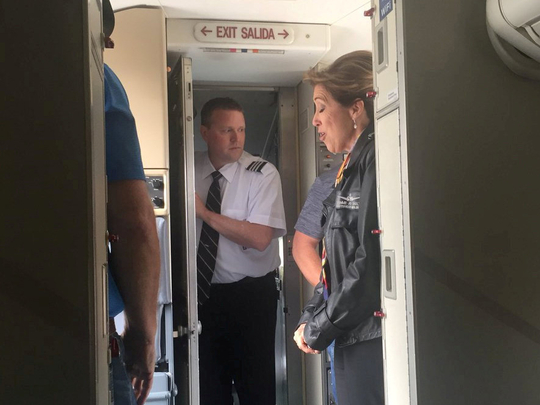
A feeling of pride swept through the small community of female pilots last Wednesday as word spread that the captain who had safely landed Southwest Airlines Flight 1380, after an engine blew out mid-air, the day before was a woman. But disappointment tempered that sentiment. Virtually all news coverage of the incident put the word “female” before “pilot”. As a private pilot, aircraft owner and aeroplane racer, I shared both the pride and the disappointment.
Why not call the hero captain simply a pilot? Was Chesley “Sully” Sullenberger — to whom Captain Tammie Jo Shults was aptly compared — referred to as a “male pilot” after landing US Airways Flight 1549 in the Hudson River?
And why the surprise that a former Navy fighter pilot and seasoned airline captain, as Shults is, could handle an emergency situation calmly and competently?
Part of it could be the numbers: In 1960, there were 25 female air transport pilots — licensed to fly for the airlines — in the United States; in 2016, there were 6,888, a huge increase, but still only 4.4 per cent of the US airline pilot population.
Overall, of nearly 600,000 pilots licensed by the Federal Aviation Administration, approximately 39,000 are women. That’s around 6 per cent, and that proportion has held steady for decades.
But lack of exposure goes only so far as an explanation. Women have been flying for more than a century, and flying professionally for nearly as long: First for aeroplane manufacturers and in air shows, then for the airlines, the military and the space programme.
The first licensed female pilot in the US, Harriet Quimby, received her certificate in 1911. The first woman pilot to fly for a commercial airline, Helen Richey, was hired in 1934.
Even someone who’s never personally seen a female pilot should be able to entertain the notion that there are flyers who don’t happen to be men.
The all-too-common refusal to recognise that a woman might be a pilot, and the frequent assumption of incompetence in female captains and first officers who have worked hard, trained hard and achieved positions of responsibility — taking lives in their hands every time they go to work — reeks of something else.
Consider these scenarios, the first of which happened to me, the second to a friend, and the third and fourth to women who have posted about the incidents on Facebook:
n The pilot who suggests that the woman with her plane parked nearby should take a “pinch-hitter” course so she can learn to land it.
n The woman who taxis her plane to the fuel pump and is greeted by a line guy blankly looking around and asking, “Where’s the pilot?”
n The commercial pilot who goes to an aviation conference and is ignored by the aeroplane salesman passing out brochures to all the other (male) pilots in the crowd, though she may well be the most experienced flyer of the lot.
n The air transport pilot who is repeatedly mistaken for a flight attendant or, if she is recognised for what she is, has to listen to passengers grumble within earshot — and sometimes to her face — that they don’t like flying with a woman in the cockpit.
Easing the looming shortage
The Boeing Pilot Outlook 2017-2036 — the most recent edition of the manufacturer’s annual report, which focused on the urgent need for air transport pilots — projects that to meet demand, North America will require 117,000 airline pilots. Based on worldwide demand, a new pilot needs to be created every 15 minutes for the next 20 years. Including more women in the applicant pool could double the number of potential hires, easing the looming shortage and making female pilots that much less of a novelty. But neither will happen if half the population is continually discouraged from even trying.
Maybe the evident piloting skill and professional calm that Shults exhibited will change that dynamic. After all, here is a woman who wasn’t allowed to train as an Air Force pilot, so she applied to aviation officer candidate school in the Navy instead, then spent a year searching for a recruiter who was willing to process her application and had to break barriers within the military to become one of the Navy’s first female fighter pilots.
She’s been facing down those unjust, sexist stereotypes her entire adult life. Maybe she’s just the person to dispel them.
— Washington Post
Beverly Weintraub, who won a Pulitzer Prize as a member of the New York Daily News editorial board, is a member of the Ninety-Nines, International Organisation of Women Pilots, and the board of directors of the Air Race Classic.









